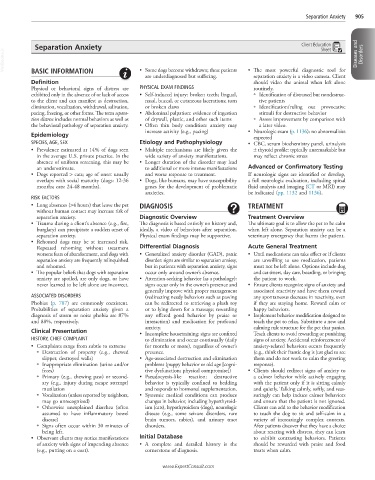Page 1808 - Cote clinical veterinary advisor dogs and cats 4th
P. 1808
Separation Anxiety 905
Separation Anxiety Client Education
Sheet
VetBooks.ir Diseases and Disorders
• Some dogs become withdrawn; these patients
BASIC INFORMATION
separation anxiety is a video camera. Client
are underdiagnosed but suffering. • The most powerful diagnostic tool for
Definition should video the animal when left alone
Physical or behavioral signs of distress are PHYSICAL EXAM FINDINGS routinely.
exhibited only in the absence of or lack of access • Self-induced injury: broken teeth; lingual, ○ Identification of distressed but nondestruc-
to the client and can manifest as destruction, nasal, buccal, or cutaneous lacerations; torn tive patients
elimination, vocalization, withdrawal, salivation, or broken claws ○ Identification/ruling out provocative
pacing, freezing, or other forms. The term separa- • Abdominal palpation: evidence of ingestion stimuli for destructive behavior
tion distress includes normal behaviors as well as of drywall, plastic, and other such items ○ Assess improvement by comparison with
the behavioral pathology of separation anxiety. • Often thin body condition: anxiety may a later video.
increase activity (e.g., pacing) • Neurologic exam (p. 1136): no abnormalities
Epidemiology expected
SPECIES, AGE, SEX Etiology and Pathophysiology • CBC, serum biochemistry panel, urinalysis
• Prevalence estimated at 14% of dogs seen • Multiple mechanisms are likely given the ± thyroid profile: typically unremarkable but
in the average U.S. private practice. In the wide variety of anxiety manifestations. may reflect chronic stress
absence of uniform screening, this may be • Longer duration of the disorder may lead
an underestimate. to additional or more intense manifestations Advanced or Confirmatory Testing
• Dogs reported > cats; age of onset usually and worse response to treatment. If neurologic signs are identified or develop,
overlaps with social maturity (dogs: 12-36 • Dogs, like humans, may have susceptibility a full neurologic evaluation, including spinal
months; cats: 24-48 months). genes for the development of problematic fluid analysis and imaging (CT or MRI) may
anxieties. be indicated (pp. 1132 and 1136).
RISK FACTORS
• Long absences (>4 hours) that leave the pet DIAGNOSIS TREATMENT
without human contact may increase risk of
separation anxiety. Diagnostic Overview Treatment Overview
• Trauma during a client’s absence (e.g., fire, The diagnosis is based entirely on history and, The ultimate goal is to allow the pet to be calm
burglary) can precipitate a sudden onset of ideally, a video of behaviors after separation. when left alone. Separation anxiety can be a
separation anxiety. Physical exam findings may be supportive. veterinary emergency that harms the patient.
• Rehomed dogs may be at increased risk.
Repeated rehoming without treatment Differential Diagnosis Acute General Treatment
worsens fears of abandonment, and dogs with • Generalized anxiety disorder (GAD), panic • Until medications can take effect or if clients
separation anxiety are frequently relinquished disorder: signs are similar to separation anxiety, are unwilling to use medication, patients
and rehomed. but in patients with separation anxiety, signs must not be left alone. Options include dog
• The popular beliefs that dogs with separation occur only around owner’s absence. and cat sitters, day care, boarding, or bringing
anxiety are spoiled, are only dogs, or have • Attention-seeking behavior (as a pathology): the patient to work.
never learned to be left alone are incorrect. signs occur only in the owner’s presence and • Ensure clients recognize signs of anxiety and
generally improve with proper management associated reactivity and have them reward
ASSOCIATED DISORDERS (redirecting needy behaviors such as pawing any spontaneous decrease in reactivity, even
Phobias (p. 787) are commonly coexistent. can be redirected to retrieving a plush toy if they are staying home. Reward calm or
Probabilities of separation anxiety given a or to lying down for a massage; rewarding happy behaviors.
diagnosis of storm or noise phobia are 87% any offered good behavior by praise or • Implement behavior modification designed to
and 88%, respectively. interaction) and medication for profound teach the pet to relax. Substitute a new and
anxiety. calming rule structure for the pet that panics.
Clinical Presentation • Incomplete housetraining: signs are confined Teach clients to avoid rewarding or punishing
HISTORY, CHIEF COMPLAINT to elimination and occur continually (daily signs of anxiety. Accidental reinforcement of
• Complaints range from subtle to extreme for months or more), regardless of owner’s anxiety-related behaviors occurs frequently
○ Destruction of property (e.g., chewed presence. (e.g., think their frantic dog is just glad to see
slipper, destroyed walls) • Age-associated destruction and elimination them and do not work to calm the greeting
○ Inappropriate elimination (urine and/or problems (puppy behavior or old age [cogni- response).
feces) tive dysfunction; physical compromise]) • Clients should redirect signs of anxiety to
○ Primary (e.g., chewing paw) or second- • Pseudocyesis-like reaction: destructive a calmer behavior while actively engaging
ary (e.g., injury during escape attempt) behavior is typically confined to bedding with the patient only if it is sitting calmly
mutilation and responds to hormonal supplementation. and quietly. Talking calmly, softly, and reas-
○ Vocalization (unless reported by neighbors, • Systemic medical conditions can produce suringly can help induce calmer behaviors
may go unrecognized) changes in behavior, including hyperthyroid- and ensure that the patient is not ignored.
○ Otherwise unexplained diarrhea (often ism (cats), hypothyroidism (dogs), neurologic Clients can add to the behavior modification
assumed to have inflammatory bowel disease (e.g., some seizure disorders, rare to teach the dog to sit and self-calm in a
disease) brain tumors, rabies), and urinary tract variety of increasingly complex contexts.
○ Signs often occur within 30 minutes of disorders. After patients discover that they have a choice
being left. about reacting with distress, they can learn
• Observant clients may notice manifestations Initial Database to exhibit contrasting behaviors. Patients
of anxiety with signs of impending absence • A complete and detailed history is the should be rewarded with praise and food
(e.g., putting on a coat). cornerstone of diagnosis. treats when calm.
www.ExpertConsult.com

